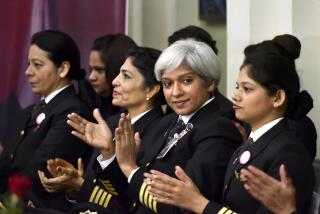S. Paul Johnston, 86, Authority on Air Power, Aviation Pioneer, Dies
- Share via
S. Paul Johnston, an authority on air power who directed the National Air and Space Museum of the Smithsonian Institution and was research coordinator for the National Advisory Committee for Aeronautics, NASA’s predecessor, has died at a hospital in Easton, Md.
Johnston, who flew biplanes during World War I and was one of the organizers of America’s emergency aircraft production program during World War II, was 86 and died Friday.
He attended Massachusetts Institute of Technology after World War I, graduating in 1921. He worked for Aluminum Co. of America developing lightweight alloys for aeronautical use but resigned in 1929 after Alcoa began to minimize its plans for airplane metals. With a former MIT professor he wrote “Aviation Handbook,” one of the first technical reference works involving aircraft and later served as editor of Aviation magazine, now Aviation Week.
As editor, Johnston traveled the world and in a 1939 article for the Saturday Evening Post was one of the first to warn of Germany’s superior air power.
He left the magazine that year to become a coordinator for the national aeronautics committee, out of which came the National Aeronautics and Space Administration. Johnston was a naval officer during World War II, working to speed airplane construction, and then directed postwar bombing surveys in Europe and Japan.
From 1946 until 1964 he was director of the Institute of Aeronautical Sciences, resigning to take over the Smithsonian’s expanded air museum where craft ranging from the Wright brothers’ first airplane to manned space capsules are on display.
Most recently Johnston had been director of the Chesapeake Bay Maritime Museum in St. Michaels, Md.
More to Read
Inside the business of entertainment
The Wide Shot brings you news, analysis and insights on everything from streaming wars to production — and what it all means for the future.
You may occasionally receive promotional content from the Los Angeles Times.









